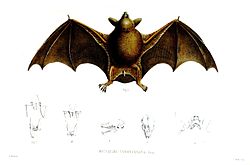| Mystacina | |
|---|---|
 | |
| New Zealand lesser short-tailed bat, (Mystacina tuberculata) | |
| Scientific classification | |
| Kingdom: | Animalia |
| Phylum: | Chordata |
| Class: | Mammalia |
| Order: | Chiroptera |
| Family: | Mystacinidae |
| Genus: | Mystacina Gray in Dieffenbach, 1843 |
| Type species | |
| Mystacina tuberculata Gray, 1843 | |
| Species | |
Mystacina is the sole surviving genus of the Mystacinidae family of bats. It has three known species, of which only the New Zealand lesser short-tailed bat (Mystacina tuberculata) is confirmed to survive today. [1] The closely related New Zealand greater short-tailed bat (Mystacina robusta) has not had a confirmed sighting since 1965 and is thought to be extinct. [2] The third species, Mystacina miocenalis , is known from the Middle Miocene, some 19–16 million years ago. [3] [4]